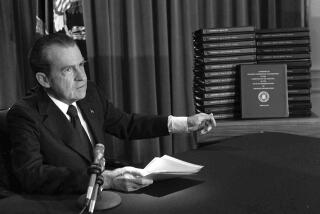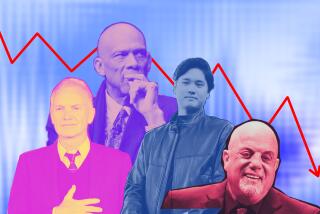Disincentivizing greed
Financial reform is now the law of the land, and by reconfiguring the banking industry and siccing watchdogs on economic shenanigans, the 2010 Dodd-Frank Wall Street Reform and Consumer Protection Act is intended to help avoid another meltdown.
If only.
The problem with nearly all attempts at financial reform, including this one, is that they try to prevent malfeasance either by changing the economic architecture, like erecting firewalls between financial sectors, or by mandating institutional curbs, like increasing reserves. But the new law gets at only proximate causes. The system malfunctioned because the human beings who ran it were greedy and saw a way to enrich themselves. That means that the recession from which we are still reeling was primarily a result of human nature, which the latest reforms don’t begin to address.
Indeed, our economic catastrophe actually can be traced to government policies that encouraged this sort of misbehavior. To change that behavior and prevent future disasters, one needs a much different and, frankly, far simpler solution than the one President Obama signed — one that disincentivizes greed.
You can’t blame financial reformers for believing that new financial arrangements will do the trick. In 1933, during the Depression, the Roosevelt administration rammed through Congress the Glass-Steagall Act. The main provision of the law separated commercial banks, like the one where you are likely to do your checking and savings, from investment banks, like the ones that deal in high finance. The idea was to protect highly regulated commercial banks from the vicissitudes and risks of the much less regulated investment banking industry, which was charged with having wrecked the economy.
The general verdict is that Glass-Steagall worked. Until its repeal in 1999, when President Clinton caved to pressures from Republicans who felt regulation inhibited competition and from Democrats — such as Clinton’s own Treasury secretary, Robert Rubin — who felt that the law was a vestige of another era, Glass-Steagall seemed more or less to keep financial abuses to a minimum. In fact, many analysts attributed the disaster of 2008 to the recklessness of investment banks that had gobbled up commercial banks once Glass-Steagall was no longer in effect — a banking/investment system run amok.
At least that was the conventional wisdom. But though Glass-Steagall may have prevented financial institutions from metastasizing into “too big to fail,” there was still all sorts of financial chicanery that the law couldn’t touch — from the savings and loan crisis in the 1980s, to the junk-bond debacle that same decade, to the inflated high-tech bubble that burst in 1999. Even when it came to its domain, investment banking, Glass-Steagall was no panacea. And that’s because it didn’t get to the primary cause either, which is also why its demise didn’t really lead to the turmoil: Glass-Steagall didn’t get to human nature.
If we’ve learned nothing else about investment banking over the last two years, we’ve learned that it operates like a virus. You can devise all sorts of economic antibiotics — from stricter regulation and more oversight to limiting certain institutional arrangements, as Glass-Steagall did — but sooner or later they are all bound to fail because financial instruments keep mutating to escape destruction. Investment bankers reconstitute highly risky, highly profitable schemes such as credit default swaps or unit contingent options or other exotic inventions. That’s why reform never works. It will always be outsmarted.
Rest assured, investment bankers don’t come up with this stuff because they enjoy the challenge of circumventing the SEC or the Fed the way John Dillinger enjoyed confounding the FBI, or because they have some sense of institutional pride in growing their firms. They come up with this stuff because they enjoy being rich(er). It is all about the Benjamins. That’s the human nature part.
Of course, human nature hasn’t changed much from the way it was during the 50 years spanning the early 1930s to the early 1980s. Glass-Steagall didn’t, and couldn’t, prevent all wrongdoing in those years, as we’ve seen, but there was less financial misconduct. Investment bankers largely toed the line, and one is hard-put to find any scandal on the scale of what we have experienced since. So what’s the explanation?
The answer is simple: In 1981, the government decided to reward greed. Top marginal tax rates — the rates on the highest earners — suddenly plummeted thanks to the Reagan tax cuts, and just as suddenly there was a huge incentive to get as much as one could no matter what one had to do to get it. In effect, the Reagan tax cuts, which were hailed by conservatives as a way to unleash American initiative, also unleashed American avarice.
To a surprising degree, economic misfortune has correlated with low top marginal tax rates. The top marginal tax rate at the time of the 1929 crash was 24%. After his election, Roosevelt promptly raised it to 63% and then to 94%, and one could easily make the case that it was this rise, rather than financial regulation, that played the primary — though certainly not the only — role in curbing abuses by attacking greed at its source, without, by the way, damaging the economy. Roosevelt essentially taxed away big money.
During the long postwar economic boom, the top marginal rates hovered at 91%, removing a lot of the incentive to game the financial system. There was no point in scheming if you couldn’t profit from it. Still, the country prospered. So did Wall Street.
Then came the greed deluge. Economics is a complicated business, and it is seldom subject to a single cause. Deregulation does play a role. But when President Reagan cut the top marginal tax rate drastically from 70% to 50% in 1981 and then to 28% in 1988 (putting aside for the moment the cut in the capital gains tax and other investment incentives), that’s when the troubles began — from the S&L crisis right through to the fall of Lehman Bros. It wasn’t enough for the rich to be rich. Human nature being what it is, they had to be super-rich. Or put another way, tax cuts, including the Bush tax cuts, fed some of the worst aspects of human nature and led to some of the worst excesses. It was just a matter of time before Wall Street went wild.
When the fire of greed is stoked this way, financial reforms cannot possibly bank it. In truth, probably nothing can. We now live in a country that seems to worship wealth, and we may just have to live with the consequences — a Bernie Madoff, an Enron, a Lehman Bros., and a steep recession when the super-rich overplay their hand. The alternative is regulation that goes to the source by raising those marginal tax rates (and capital gains taxes) and forcing the super-rich to merely be rich again. And honestly, that’s not going to happen. It would be a violation of human nature.
Neal Gabler is a public policy scholar at the Woodrow Wilson Center in Washington. He is writing a biography of Ted Kennedy.
More to Read
Inside the business of entertainment
The Wide Shot brings you news, analysis and insights on everything from streaming wars to production — and what it all means for the future.
You may occasionally receive promotional content from the Los Angeles Times.









